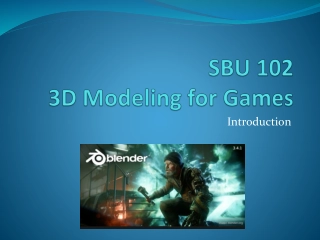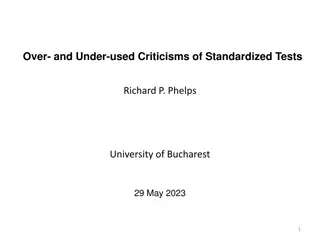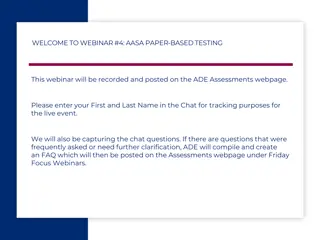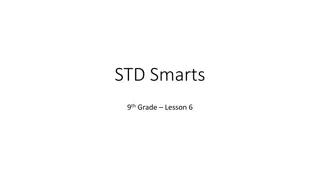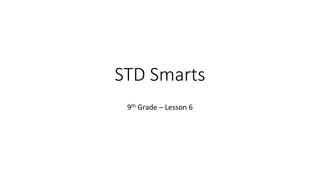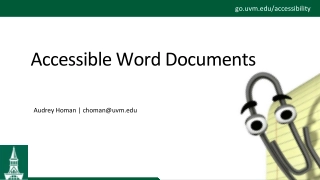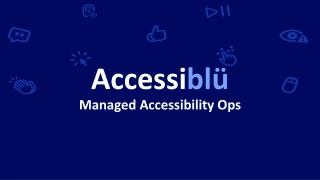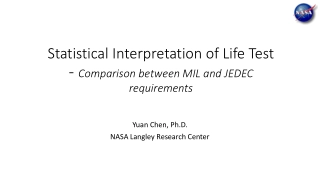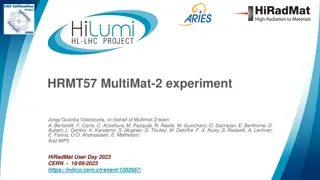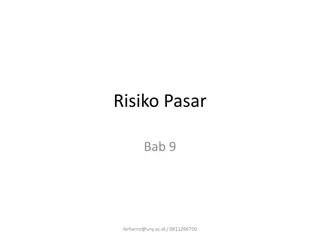1 - animation testing
asd asdasd asdas dsad
Download Presentation
Please find below an Image/Link to download the presentation.
The content on the website is provided AS IS for your information and personal use only. It may not be sold, licensed, or shared on other websites without obtaining consent from the author. Download presentation by click this link. If you encounter any issues during the download, it is possible that the publisher has removed the file from their server.
Presentation Transcript
Introduction to Chatbots and Dialogue Systems Chatbots and Dialogue Systems
Dialogue Systems and Chatbots Personal Assistants on phones or other devices SIRI, Alexa, Cortana, Google Assistant Playing music, setting timers, reading recipes Booking reservations Answering questions Creative writing Editing or rewriting text Writing code
Two kinds of dialogue system architectures 1. Frame-based Task-oriented Dialogue Systems Can talk to users to accomplish simple fixed tasks simple personal assistants (Siri, Alexa) booking flights or finding restaurants 2. LLM Chatbots Can talk to users to do many tasks with text or code Answering questions Writing, summarizing , or editing text or code Are quickly acquiring abilities to act as agents
Task-based dialogue agents "Task-based" or "goal-based" dialogueagents Systems that have the goal of helping a user solve a task Setting a timer Making a travel reservation Playing a song Buying a product Architecture: Frames with slots and values A knowledge structure representing user intentions
The Frame A set of slots, to be filled with information of a given type Each associated with a question to the user Slot ORIGIN DEST DEP DATE date DEP TIME time AIRLINE line Type city city Question "What city are you leaving from? "Where are you going? "What day would you like to leave? "What time would you like to leave? "What is your preferred airline?
Dialogue agents based on large language models Like ChatGPT: based on large language models like GPT pretrained to predict words. These language models are fine-tuned to carry on conversation and follow instructions They can also retrieve text as part of answering questions or chatting retrieval-augmented generation (RAG)
Implications for Human Users Weizenbaum, Joseph. 1966, "ELIZA - A Computer Program For the Study of Natural Language Communication Between Man And Machine", Communications of the ACM 9 (1): 36-45 ELIZA: Weizenbaum (1966) Men are all alike. IN WHAT WAY They're always bugging us about something or other. CAN YOU THINK OF A SPECIFIC EXAMPLE Well, my boyfriend made me come here. YOUR BOYFRIEND MADE YOU COME HERE He says I'm depressed much of the time. I AM SORRY TO HEAR YOU ARE DEPRESSED
ELIZA reflects the user's statements back at them Based on simple rules: (.*) YOU (.*) ME WHAT MAKES YOU THINK I \2 YOU Transforms: User: You hate me into the response System: "WHAT MAKES YOU THINK I HATE YOU "
Chatbots can have significant influences on people s cognitive and emotional state. In Weizenbaum's study, people became emotionally involved with the program, asking him to leave the room when they were typing. Reeves and Nass (1996) The Media Equation People tend to assign human characteristics to computers People interpret an utterance in the way they would if it had spoken by a human
Chatbots have privacy implications Weizenbaum suggested storing the ELIZA conversations for later analysis People immediately pointed out the privacy implications Modern chatbots in the home are likely to overhear private information If a chatbot is human-like, users are more likely to disclose private information, and yet less likely to worry about the harm of this disclosure.
We'll see more on all these topics Some properties of human conversation The frame-based architecture for dialogue systems LLM-based chatbots Evaluation Ethical and design issues
Introduction to Chatbots and Dialogue Systems Chatbots and Dialogue Systems
Properties of Human Conversation Chatbots and Dialogue Systems
A telephone conversation between a human travel agent (A) and a human client (C)
Properties of Human Conversation Turns We call each contribution a "turn" As if conversation was the kind of game where everyone takes turns. 15
Properties of Human Conversation Turn-taking issues When to take the floor? When to yield the floor? Interruptions 17
Implications for Conversational Agents Barge-in Allowing the user to interrupt End-pointing The task for a speech system of deciding whether the user has stopped talking. Very hard, since people often pause in the middle of turns 19
Language as Action Each turn in a dialogue is a kind of action Wittgenstein (1953) and Austin (1962)
Speech Acts (aka Dialogue Acts) Bach and Harnish (1979) Constatives: committing the speaker to something s being the case (answering, claiming, confirming, denying, disagreeing, stating) Directives: attempts by the speaker to get the addressee to do something (advising, asking, forbidding, inviting, ordering, requesting) Commissives: committing the speaker to some future course of action (promising, planning, vowing, betting, opposing) Acknowledgments: express the speaker s attitude regarding the hearer with respect to some social action (apologizing, greeting, thanking, accepting an acknowledgment)
Speech acts "Turn up the music!" DIRECTIVE "What day in May do you want to travel?" DIRECTIVE "I need to travel in May" CONSTATIVE Thanks ACKNOWLEDGEMENT
Grounding Participants in conversation or any joint activity need to establish common ground. Principle of closure. Agents performing an action require evidence, sufficient for current purposes, that they have succeeded in performing it (Clark 1996, after Norman 1988) Speech is an action too! So speakers need to ground each other s utterances. Grounding: acknowledging that the hearer has understood
Grounding Grounding is relevant for human-machine interaction Why do elevator buttons light up?
Grounding: Establishing Common Ground A: And you said returning on May 15th? C: Uh, yeah, at the end of the day. A: OK C: OK I ll take the 5ish flight on the night before on the 11th. A: On the 11th? OK. C: ...I need to travel in May. A: And, what day in May did you want to travel?
Grounding is important for computers too! Cohen et al (2004) System: Did you want to review some more of your profile? User: No. System: What s next? Awkward! System: Did you want to review some more of your profile? User: No. System: Okay, what s next? Less Awkward!
Conversations have structure Local structure between adjacent speech acts, from the field of conversational analysis (Sacks et al. 1974) Called adjacency pairs: QUESTION ANSWER PROPOSAL ACCEPTANCE/REJECTION COMPLIMENTS("Nice jacket!") DOWNPLAYER ("Oh, this old thing?")
Another kind of structure: Subdialogues Correction subdialogue Agent: OK. There's #two non-stops# Client: #Act- actually#, what day of the week is the 15th? Agent: It s a Friday. Client: Uh hmm. I would consider staying there an extra day til Sunday. Agent: OK...OK. On Sunday I have ... 28
Clarification Subdialogues User: What do you have going to UNKNOWN WORD on the 5th? System: Let s see, going where on the 5th? User: Going to Hong Kong. System: OK, here are some flights... 29
Presequences User: Can you make train reservations? System: Yes I can. User: Great, I d like to reserve a seat on the 4pm train to New York.
Conversational Initiative Some conversations are controlled by one person A reporter interviewing a chef asks questions, and the chef responds. This reporter has the conversational initiative (Walker and Whittaker 1990) Most human conversations have mixed initiative: I lead, then you lead, then I lead. Mixed initiative is very hard for NLP systems, which often default to simpler styles that can be frustrating for humans: User initiative (user asks or commands, system responds) System initiative (system asks user questions to fill out a form, user can't change the direction)
Even harder problems: Inference Agent: And, what day in May did you want to travel? Client: OK, uh, I need to be there for a meeting that s from the 12th to the 15th.
Properties of Human Conversation Chatbots and Dialogue Systems
Rule-based Chatbots: ELIZA and PARRY Chatbots and Dialogue Systems
ELIZA: Weizenbaum (1966) Men are all alike. IN WHAT WAY They're always bugging us about something or other. CAN YOU THINK OF A SPECIFIC EXAMPLE Well, my boyfriend made me come here. YOUR BOYFRIEND MADE YOU COME HERE He says I'm depressed much of the time. I AM SORRY TO HEAR YOU ARE DEPRESSED Weizenbaum, Joseph. 1966, "ELIZA - A Computer Program For the Study of Natural Language Communication Between Man And Machine", Communications of the ACM 9 (1): 36-45 ... You are like my father in some ways. WHAT RESEMBLANCE DO YOU SEE You are not very aggressive but I think you don t want me to notice that. WHAT MAKES YOU THINK I AM NOT AGGRESSIVE You don t argue with me. WHY DO YOU THINK I DON T ARGUE WITH YOU You are afraid of me. DOES IT PLEASE YOU TO BELIEVE I M AFRAID OF YOU My father is afraid of everybody. WHAT ELSE COMES TO MIND WHEN YOU THINK OF YOUR FATHER Bullies. DOES THAT HAVE ANYTHING TO DO WITH THE FACT THAT YOUR BOYFRIEND MADE YOU COME HERE
ELIZA's trick: be a Rogerian psychologist Draw the patient out by reflecting patient s statements back at them Rare type of conversation in which one can assume the pose of knowing almost nothing of the real world
Rogerian psychologist Patient: "I went for a long boat ride Psychologist: "Tell me about boats You don t assume she didn t know what a boat is You assume she had some conversational goal Chatbots trying to pass the Turing test usually choose some such domain
Eliza pattern/transform rules (0 YOU 0 ME) (WHAT MAKES YOU THINK I 3 YOU) [transform] [pattern] 0 means Kleene * The 3 is the constituent # in pattern You hate me WHAT MAKES YOU THINK I HATE YOU
Eliza Rules Rules are organized by keywords Each keyword has a pattern and a list of possible transform Keyword: YOU Pattern: Transforms: (WHAT MAKES YOU THINK I 3 YOU) (WHY DO YOU THINK I 3 YOU) (0 YOU 0 ME) keyword pattern list of transforms
Keywords are ranked from specific to general User: I know everybody laughed at me I is very general: I: (I *) -> (YOU SAY YOU 2) ELIZA: YOU SAY YOU KNOW EVERYBODY LAUGHED AT YOU Everybody is more specific and interesting Everybody: (Everybody *) -> (WHO IN PARTICULAR ARE YOU THINKING OF) ELIZA: WHO IN PARTICULAR ARE YOU THINKING OF? Implementation: keywords stored with their rank Everybody 5 (list of transformation rules) I 0 (list of transformation rules)
NONE PLEASE GO ON THAT S VERY INTERESTING I SEE
Memory (MEMORY MY (0 MY 0 = LETS DISCUSS FURTHER WHY YOUR 3) (0 MY 0 = EARLIER YOU SAID YOUR 3) (0 MY 0 = DOES THAT HAVE ANYTHING TO DO WITH THE FACT THAT YOUR 3)) Whenever MY is highest keyword Randomly select a transform on the MEMORY list Apply to sentence Store on a (first-in-first-out) queue Later, if no keyword matches a sentence Return the top of the MEMORY queue instead
Ethical implications: Anthropomorphism and Privacy People became deeply emotionally involved with the program One of Weizenbaum's staff asked him to leave the room when she talked with ELIZA When he suggested that he might want to store all the ELIZA conversations for later analysis, people immediately pointed out the privacy implications Suggesting that they were having quite private conversations with ELIZA Despite knowing that it was just software.
Ethical implications It worried Weizenbaum that people confided in ELIZA Were people misled about how much computers understood? Turkle studied users of ELIZA and other systems Turkle has shown human face-to-face interaction is vital But people also develop specific relationships with artifacts Some users told her ELIZA was more like a kind of diary, a way to privately explore their thoughts. Importance of value-sensitive design Joseph Weizenbaum. 1976. Computer Power and Human Reason: From Judgment to Calculation. WH Freeman. Sherry Turkle. 2011. Taking Things at Interface Value, chapter in Life on the Screen. Simon and Schuster. Sherry Turkle. 2007. Authenticity in the age of digital companions. Interaction Studies, 8(3), pp.501-517
46 PARRY: A computational model of schizophrenia Another chatbot with a clinical psychology focus Colby, K. M., Weber, S., and Hilf, F. D. (1971). Artificial paranoia. Artificial Intelligence 2(1), 1 25. Used to study schizophrenia Same pattern-response structure as Eliza But a much richer: control structure language understanding capabilities model of mental state. variables modeling levels of Anger, Fear, Mistrust
Affect variables Fear (0-20) Anger (0-20) Mistrust (0-15) Start with all variables low After each user turn Eachuser statement can change Fear and Anger E.g., Insults increases Anger, Flattery decreases Anger Mentions of his delusions increase Fear Else if nothing malevolent in input Anger, Fear, Mistrust all drop
Parry's responses depend on mental state User Input Modify Affect variables Input mentions delusion topic excessive anger excessive fear condition question response Hostility Fear answer Escape
49 PARRY passes the Turing test in 1972 The first system to pass a version of the Turing test Psychiatrists couldn t distinguish interviews with PARRY from (text transcripts of) interviews with people diagnosed with paranoid schizophrenia Colby, K. M., Hilf, F. D., Weber, S., and Kraemer, H. C. (1972). Turing-like indistinguishability tests for the validation of a computer simulation of paranoid processes. Artificial Intelligence 3, 199 221.
Rule-based Chatbots: ELIZA and PARRY Chatbots and Dialogue Systems





